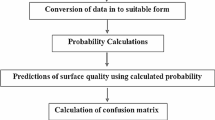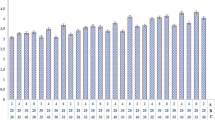Abstract
This work aimed to improve the surface quality and precision in machining process and speed up intelligent production. Hence, this work proposed a grinding process from a control perspective which provides a cognitive decision-making process. From this viewpoint, a new approach to measure the amount of grinding wheel wear and predict the surface roughness was designed by the authors on the basis of the compressed air measuring head and hybrid algorithms between fuzzy neural networks (i.e., ANFIS)—Gaussian regression function (i.e., GPR) and Taguchi empirical analysis. A series of experiments was conducted under different processing conditions. Results showed that the proposed method can measure the abrasive wear and predict the surface roughness accurately during Ti-6Al-4V titanium alloy grinding. The proposed model can predict surface roughness values with an error rate of 0.31% and a confidence interval of 98%. This study laid the foundation for monitoring the grinding wheel wear and the surface roughness in real-life industrial environments.
Similar content being viewed by others
References
Sun FJ, Qu SG, Pan YX, Li XQ, Li FL (2015) Effects of cutting parameters on dry machining Ti-6Al-4V alloy with ultra-hard tools. Int J Adv Manuf Technol 79(1–4):351–360. https://doi.org/10.1007/s00170-014-6717-3
Gariani S, Shyha I, Inam F, Huo D (2017) Experimental analysis of system parameters for minimum cutting fluid consumption when machining Ti-6Al-4V using a novel supply system. Int J Adv Manuf Technol 95(5–8):2795–2809. https://doi.org/10.1007/s00170-017-1216-y
Yi S, Li G, Ding S, Mo J (2017) Performance and mechanisms of graphene oxide suspended cutting fluid in the drilling of titanium alloy Ti-6Al-4V. J Manuf Process 29:182–193. https://doi.org/10.1016/j.jmapro.2017.07.027
Ezugwu EO, Batista Da Silva R, Falco Sales W, Rocha Machado A (2017) Overview of the machining of titanium alloys. In: Encyclopedia of sustainable technologies, pp 487–506. https://doi.org/10.1016/b978-0-12-409548-9.10216-7
Koseki S, Inoue K, Sekiya K, Morito S, Ohba T, Usuki H (2017) Wear mechanisms of PVD-coated cutting tools during continuous turning of Ti-6Al-4V alloy. Precis Eng 47:434–444. https://doi.org/10.1016/j.precisioneng.2016.09.018
Revankar GD, Shetty R, Rao SS, Gaitonde VN (2017) Wear resistance enhancement of titanium alloy (Ti–6Al–4V) by ball burnishing process. Journal of Materials Research and Technology 6(1):13–32. https://doi.org/10.1016/j.jmrt.2016.03.007
Kacalak W, Lipiński D, Bałasz B, Rypina Ł, Tandecka K, Szafraniec F (2017) Performance evaluation of the grinding wheel with aggregates of grains in grinding of Ti-6Al-4V titanium alloy. Int J Adv Manuf Technol 94(1–4):301–314. https://doi.org/10.1007/s00170-017-0905-x
Wang J, Shimada K, Mizutani M, Kuriyagawa T (2018) Tool wear mechanism and its relation to material removal in ultrasonic machining. Wear 394-395:96–108. https://doi.org/10.1016/j.wear.2017.10.010
Wirtz C, Dehmer A, Trauth D, Mattfeld P, Klocke F (2018) Analysis of the grinding wheel wear in dependency of the cemented carbide specification. Int J Adv Manuf Technol 99:747–754. https://doi.org/10.1007/s00170-018-2362-6
Ding W, Dai C, Yu T, Xu J, Fu Y (2017) Grinding performance of textured monolayer CBN wheels: undeformed chip thickness nonuniformity modeling and ground surface topography prediction. Int J Mach Tools Manuf 122:66–80. https://doi.org/10.1016/j.ijmachtools.2017.05.006
Xiang D, Zhou Z, Liu Z, Yao Y, Guo Z (2017) Abrasive wear of a single CBN grain in ultrasonic-assisted high-speed grinding. Int J Adv Manuf Technol 98(1–4):67–75. https://doi.org/10.1007/s00170-017-0409-8
Novoselov Y, Bratan S, Bogutsky V (2016) Analysis of relation between grinding wheel wear and abrasive grains Wear. Procedia Engineering 150:809–814. https://doi.org/10.1016/j.proeng.2016.07.116
Wegener K, Bleicher F, Krajnik P, Hoffmeister H-W, Brecher C (2017) Recent developments in grinding machines. CIRP Ann 66(2):779–802. https://doi.org/10.1016/j.cirp.2017.05.006
Ahrens M, Damm J, Dagen M, Denkena B, Ortmaier T (2017) Estimation of dynamic grinding wheel wear in plunge grinding. Procedia CIRP 58:422–427. https://doi.org/10.1016/j.procir.2017.03.247
Darafon A, Warkentin A, Bauer R (2013) Characterization of grinding wheel topography using a white chromatic sensor. Int J Mach Tools Manuf 70:22–31. https://doi.org/10.1016/j.ijmachtools.2013.03.003
Taheri K, Gadow R (2017) Industrial compressed air system analysis: exergy and thermoeconomic analysis. CIRP J Manuf Sci Technol 18:10–17. https://doi.org/10.1016/j.cirpj.2017.04.004
Bhuiyan MSH, Choudhury IA (2014) Review of sensor applications in tool condition monitoring in machining.539–569. doi:https://doi.org/10.1016/b978-0-08-096532-1.01330-3
Zhang G, Sun H (2017) Enabling a cutting tool iPSS based on tool condition monitoring. Int J Adv Manuf Technol 94(9–12):3265–3274. https://doi.org/10.1007/s00170-017-0852-6
D’Addona DM, Matarazzo D, Teti R, de Aguiar PR, Bianchi EC, Fornaro A (2017) Prediction of dressing in grinding operation via neural networks. Procedia CIRP 62:305–310. https://doi.org/10.1016/j.procir.2017.03.043
Venkata Rao K, Murthy BSN, Mohan Rao N (2014) Prediction of cutting tool wear, surface roughness and vibration of work piece in boring of AISI 316 steel with artificial neural network. Measurement 51:63–70. https://doi.org/10.1016/j.measurement.2014.01.024
Rizal M, Ghani JA, Nuawi MZ, Haron CHC (2013) Online tool wear prediction system in the turning process using an adaptive neuro-fuzzy inference system. Appl Soft Comput 13(4):1960–1968. https://doi.org/10.1016/j.asoc.2012.11.043
Quiza R, Figueira L, Paulo Davim J (2007) Comparing statistical models and artificial neural networks on predicting the tool wear in hard machining D2 AISI steel. Int J Adv Manuf Technol 37(7–8):641–648. https://doi.org/10.1007/s00170-007-0999-7
Chen D-D, Lin YC, Zhou Y, Chen M-S, Wen D-X (2017) Dislocation substructures evolution and an adaptive-network-based fuzzy inference system model for constitutive behavior of a Ni-based superalloy during hot deformation. J Alloys Compd 708:938–946. https://doi.org/10.1016/j.jallcom.2017.03.029
Kuo RJ, PHC (1999) Multi-sensor integration for on-line tool wear estimation through radial basis function networks and fuzzy neural network. Neural Networks 12(12):355–370
A. Gajate RH, R.d. Toro, P. Vega, A. Bustillo (2010) Tool wear monitoring using neuro-fuzzy techniques: a comparative study in a turning process. J Intell Manuf 1 (14). https://doi.org/10.1007/s10845-010-0443-y
Alonso FJ, Salgado DR (2008) Analysis of the structure of vibration signals for tool wear detection. Mech Syst Signal Process 22(3):735–748. https://doi.org/10.1016/j.ymssp.2007.09.012
Kong DD, Chen YJ, Li N, Tan SL (2017) Tool wear monitoring based on kernel principal component analysis and v-support vector regression. Int J Adv Manuf Technol 89:175–190. https://doi.org/10.1007/s00170-016-9070-x
D. Wu CJ JT, R.X. Gao, S. Kumara. (2017) A comparative study on machine learning algorithms for smart manufacturing: tool wear prediction using random forests. Manuf 139(7):071018−071024. https://doi.org/10.1115/1.4036350
Hasselmo ME, Mozer MC, Touretzky DS (1996) Gaussian Processes for Regression. MIT Press, Massachusetts
Wang B, Chen T (2015) Gaussian process regression with multiple response variables. Chemom Intell Lab Syst 142:159–165. https://doi.org/10.1016/j.chemolab.2015.01.016
Chauhan R, Singh T, Kumar N, Patnaik A, Thakur NS (2017) Experimental investigation and optimization of impinging jet solar thermal collector by Taguchi method. Appl Therm Eng 116:100–109. https://doi.org/10.1016/j.applthermaleng.2017.01.025
Kong X, Yang L, Zhang H, Chi G, Wang Y (2016) Optimization of surface roughness in laser-assisted machining of metal matrix composites using Taguchi method. Int J Adv Manuf Technol 89(1–4):529–542. https://doi.org/10.1007/s00170-016-9115-1
Shrivastava PK, Pandey AK (2018) Geometrical quality evaluation in laser cutting of Inconel-718 sheet by using Taguchi based regression analysis and particle swarm optimization. Infrared Phys Technol 89:369–380. https://doi.org/10.1016/j.infrared.2018.01.028
Gholami MH, Azizi MR (2014) Constrained grinding optimization for time, cost, and surface roughness using NSGA-II. Int J Adv Manuf Technol 73(5–8):981–988. https://doi.org/10.1007/s00170-014-5884-6
Malkin S (2008) In: Edition S (ed) Grinding technology - theory and applications of machining with abrasives. Industrial press, New York
Alexandre FA, Lopes WN, Lofrano Dotto FR, Ferreira FI, Aguiar PR, Bianchi EC, Lopes JC (2018) Tool condition monitoring of aluminum oxide grinding wheel using AE and fuzzy model. Int J Adv Manuf Technol. https://doi.org/10.1007/s00170-018-1582-0
Young H-T, Chen D-J (2005) Online dressing of profile grinding wheels. Int J Adv Manuf Technol 27(9–10):883–888. https://doi.org/10.1007/s00170-004-2271-8
Wager JG (1967) Surface effects in pneumatic gauging. International Journal of Machine Tool Design and Research 7(1):1–14. https://doi.org/10.1016/0020-7357(67)90021-2
Koshy P, Grandy D, Klocke F (2011) Pneumatic non-contact topography characterization of finish-ground surfaces using multivariate projection methods. Precis Eng 35(2):282–288. https://doi.org/10.1016/j.precisioneng.2010.11.001
Tönshoff HK II (2001) Sensors in manufacturing, vol 1. Wiley-VCH, Weinheim
Ivanyshyn Yaman O, Kress R (2017) Nonlinear integral equations for Bernoulli’s free boundary value problem in three dimensions. Computers & Mathematics with Applications 74(11):2784–2791. https://doi.org/10.1016/j.camwa.2017.06.011
Järveläinen M, Kaleva A, Kaitajärvi A, Laakso J, Kanerva U, Levänen E (2016) Compression curve analysis and compressive strength measurement of brittle granule beds in lieu of individual granule measurements. Particuology 29:60–68. https://doi.org/10.1016/j.partic.2015.10.006
Li X, Zhou R, Yao W, Fan X (2017) Flow characteristic of highly underexpanded jets from various nozzle geometries. Appl Therm Eng 125:240–253. https://doi.org/10.1016/j.applthermaleng.2017.07.002
Nehler T (2018) Linking energy efficiency measures in industrial compressed air systems with non-energy benefits—a review. Renew Sust Energ Rev 89:72–87. https://doi.org/10.1016/j.rser.2018.02.018
Guo H, Xu Y, Chen H, Zhou X (2016) Thermodynamic characteristics of a novel supercritical compressed air energy storage system. Energy Convers Manag 115:167–177. https://doi.org/10.1016/j.enconman.2016.01.051
Grandy D, Koshy P, Klocke F (2009) Pneumatic non-contact roughness assessment of moving surfaces. CIRP Ann 58(1):515–518. https://doi.org/10.1016/j.cirp.2009.03.121
Balaji M, Murthy BSN, Rao NM (2016) Optimization of cutting parameters in drilling of AISI 304 stainless steel using Taguchi and ANOVA. Procedia Technology 25:1106–1113. https://doi.org/10.1016/j.protcy.2016.08.217
Rathee P, Kamboj A, Sidhu S (2016) Optimization and development of Nisoldipine nano-bioenhancers by novel orthogonal array (L27 array). Int J Biol Macromol 86:556–561. https://doi.org/10.1016/j.ijbiomac.2016.01.097
Acknowledgments
This work is financially supported by the National Natural Science Foundation of China (Grant No. 51175167), and the Science and Technology Planning Project of Hunan Province (No. 2016TP1008).
Author information
Authors and Affiliations
Corresponding author
Ethics declarations
Conflict of interest
The authors declare that they have no conflict of interest.
Rights and permissions
About this article
Cite this article
Yin, S., Nguyen, D., Chen, F. et al. Application of compressed air in the online monitoring of surface roughness and grinding wheel wear when grinding Ti-6Al-4V titanium alloy. Int J Adv Manuf Technol 101, 1315–1331 (2019). https://doi.org/10.1007/s00170-018-2909-6
Received:
Accepted:
Published:
Issue Date:
DOI: https://doi.org/10.1007/s00170-018-2909-6




